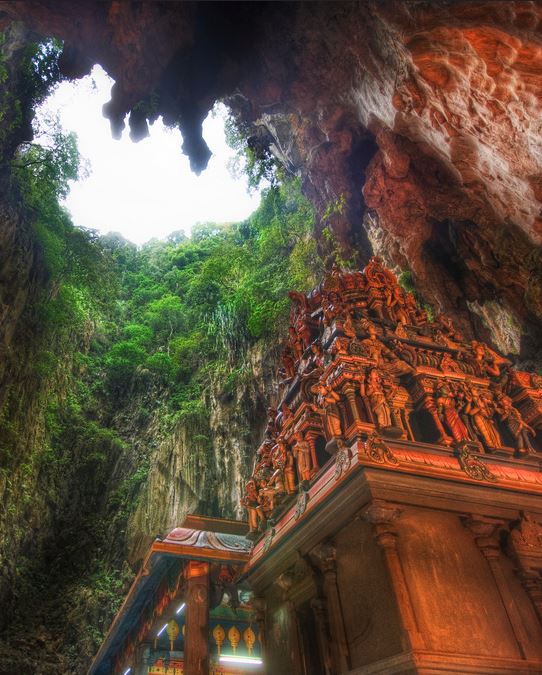
The Batu Caves of West Malaysia
The world is indeed small, and getting more so as our daily lives become ever more connected in this age of the internet and expanding global technologies. But these connections and crossovers are hardly new to the human family. From the very beginning, we have sought out each other – whether to conquer, to trade, to influence, or to share.
One such connection weaves its many threads between much of Southeast Asia and India, which had established trade and cultural and political relations with the kingdoms in Burma, Thailand, Indonesia, Malay Peninsula, Cambodia and Vietnam. That influence is said to have started as early as 200 BC. As India grew in prominence so did its power to impact other cultures. Indian traders, adventurers, teachers and priests continued to be the dominating influence in Southeast Asia until about 1500 CE. These traders brought with them their civilization, cultures and religions. Indian leaders even ruled over some of the earliest states in these regions. Hinduism and Buddhism both spread to these states from India and for many centuries coexisted. Not limited to religion, they also brought new ideas about the arts, foods, architecture, engineering and more.
Angkor Wat, Cambodia
The Khmer Empire inherited several earlier influences from India. Numerous impressive temples and monuments were built in successive centuries in order to praise the Hindu gods; and often including engineering techniques learned from Indian builders. The temples of the Angkor area near Siem Reap number more than 1,000. They range in scale from tumbled down piles of rubble like that found in much of the Koh Ker temple ruins to the stunning temples of Angkor Wat. These fabled, once-list temples are, and rightfully should be, on many travelers’ bucket lists. Explore the Rural Landscapes of Laos & Cambodia.
Batu Caves, Malaysia
Many aspects of Indian culture penetrated Malaysia, and traces can be found in the language and food. Indian food is commonly spicy, including curry and chilly. These ingredients are also used in everyday cooking here. Indian coffee stalls are popular with everyone. Here, you might see many people crowding at the shops to enjoy the ‘Teh Tarik’ known to many as the unofficial official drink for Malaysians. One of the most noted Indian-influenced sites is Batu Caves, home to a series of caves and cave temples north of Kuala Lumpur. This is among the most honored Hindu shrines outside of India. In 1890, the site was promoted as a place of worship by an Indian trader, who dedicated a temple to Lord Murugan within Temple Cave, which now includes several Hindu shrines beneath its high vaulted ceiling. Since 1892, the Thaipusam festival has been celebrated in the Tamil month of Thai, which falls in late January/early February. Wooden steps up to the Temple Cave were built in 1920 and have since been replaced by 272 concrete steps. Temple Cave. Begin here to plan a Custom Malaysia adventure.
Nakorn Ratchasima, Thailand
For more than a thousand years, India and Thailand have been neighbors, so it’s no surprise that these two share many things. India was the stronger force and therefore had a more prominent influence on Thailand, which resulted in an adaptation of Indian culture, language and religion. They have also adopted typical Indian traditions in cuisine, art and clothing styles. The single most significant factor was India’s introduction of Buddhism as early as the 3rd Century BC by Buddhist monks. Nakorn Ratchasima, commonly called Korat, was, prior to the 14th century, under Khmer empire. Indeed, the Phimai Historical Park protects one of the most important Khmer temples of Thailand. The temple marks one end of the Ancient Khmer Highway from Angkor. Most buildings are from the late 11th to the late 12th century, built in the Baphuon, Bayon and Angkor Wat style. However, even though the Khmer at that time were Hindu, the temple was built as a Buddhist temple as Buddhism in Khorat area dated back to the 7th century. Our Central Thailand journey explores this dramatic region.
Bagan, Myanmar
As happened in the much of Southeast Asia, Myanmar, formerly Burma, experienced contact with the Indian merchants, who had traveled the region to trade, bringing with them their cultures, customs and religions. Under this increasing influence, the local Burmese began to practice a blend of Buddhism and Hinduism while holding on to many of their own beliefs and customs. Myanmar is home to the Bagan, a spectacular plain stretching away from the Ayeyarwaddy River, dotted with thousands of 800-year-old temple ruins. During Bagan’s height between the 11th and 13th centuries, more than 10,000 Buddhist temples, pagodas and monasteries were constructed here. There are some 2,200 temples and pagodas that still survive to the present day. Imagine seeing this incredible site on an early morning hot air balloon ride? You can do that on our 10-day Myanmar adventure.
Central Bhutan
Another neighbor, Bhutan has had close links to India for centuries. Buddhism was originally introduced from India in the 8th century, although the Buddhism of today’s Bhutan is more Tibetan in character. About 75% of the Bhutanese practice Buddhism and about 25% practice Indian- and Nepalese-influenced Hinduism. An Indian military training camp has been established there since the early 1960s and India provides financial aid. But influences come from both India and China. You find Northern Indian cuisine in Bhutan often mixed with the chilies of the Tibetan area. Spices, fruits, and vegetables are cooked with beef, chicken, pork, and dried yak, and resemble Chinese and Indian cuisine. The legal system is based on English common law and Indian law. Discover this amazing country on our Central Bhutan exploration.